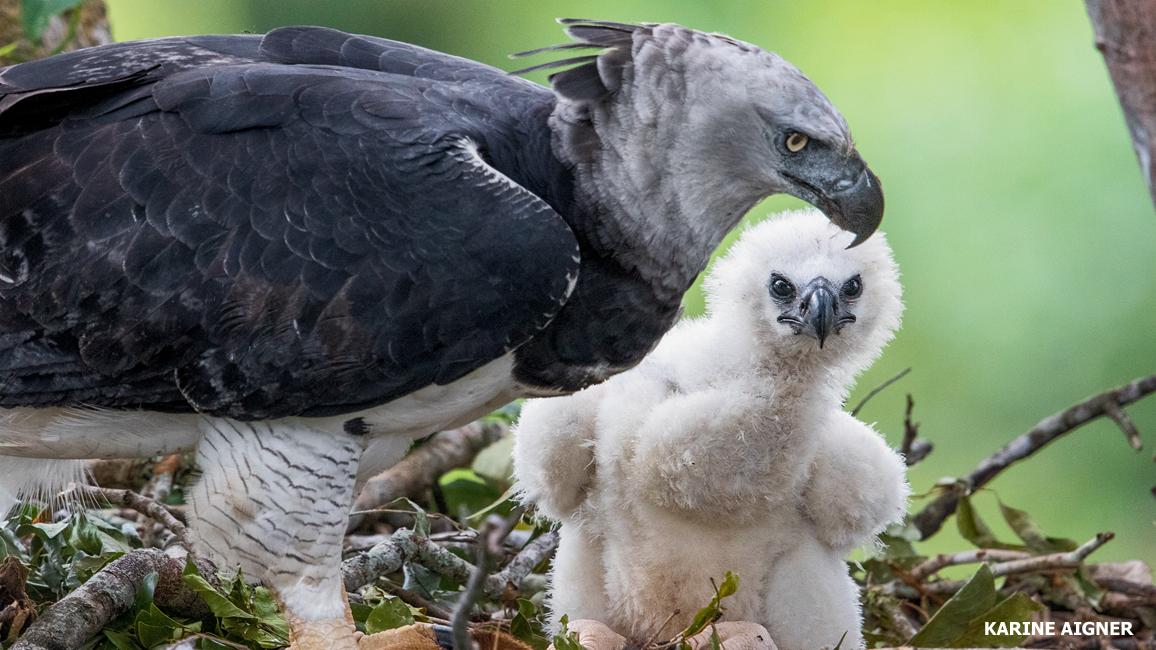
Hooray for Harpies!
By Ellen Lambeth; photos by Karine AignerThis may be one of the biggest, strongest birds in the whole world. Even so, it needs a helping hand.

High up in one of the forest’s tallest trees sits the nest of a harpy eagle. And in that nest is a mother harpy and her wee, white chick. With Mom’s and her mate’s hard work over the next two years or so—and a little luck—the chick will grow up to be a fierce, powerful hunter like its parents. And with even more luck, it will someday find a mate, build a nest, and raise a family of its own.
The bad news is, there’s much less forest than there once was—and far fewer prime nesting trees. Harpy eagles live in tropical rainforests from southern Mexico, through Central America, and into South America (see map). But they are rare now and hard to find. The harpy family in this story lives in Brazil. Come take a closer look.

What Makes a Harpy a Harpy?
Eagles are birds of prey. That means they hunt and eat other animals. They’re also big birds with big feet, big beaks, and strong, sharp talons (claws). And the harpy eagle may very well be the most powerful one of them all.
A harpy may weigh as much as a toddler and be as long from head to tail as you are tall. Its open wings may stretch six and a half feet. Its legs can be as big around as your arms, with talons the size of a grizzly bear’s claws. When a harpy eagle is annoyed or angry, it raises a crown of feathers on its head that makes it look even bigger and tougher. In other words, don’t mess with a harpy!
Living the Harpy Life
Harpy eagles have big appetites. They use their powerful feet and talons to pluck most of their prey right out of the trees. Some of their favorites are monkeys, sloths, and porcupines. They also may grab large iguanas, snakes, and parrots. Sometimes they catch ground-dwelling animals such as armadillos or young wild pigs.
Harpies nest in big, tall trees that poke above the tops of the other trees in the forest. That may be higher up than the top of a 10-story building! After a pair builds the nest, Mama lays an egg or two, but usually raises only one chick. She stays on the nest nearly full-time for half a year, while Papa hunts and delivers the meals.

Disappearing Forest
This huge area in Brazil, called the Amazon rainforest, is home to one-tenth of all the world’s known species. But in recent years, more and more of the forest has been burned and cleared to make way for farms and cattle ranches. That means less and less room for wildlife, including harpy eagles.
As so many acres of trees disappear, species such as the harpy become rare and threatened with extinction. But there are still some harpies out there, and it takes scientists such as Everton Miranda to find them—and to find ways to help protect them.
Oh, Nuts!
Everton traveled to an area where the forest was rapidly disappearing. He looked for the tall Brazil nut trees that he knew the eagles liked to nest in. He played recordings of the eagle’s call on his phone to see if a real eagle would respond. But he had trouble finding the birds. He decided to get some help from the local people.
Who would know best how to find the biggest Brazil nut trees? Workers who collect the nuts to sell! Not only did the nut collectors know where the trees were, they also knew which ones had active harpy nests. How? Because eagle parents are very loud and protective whenever any sign of danger approaches—even if the workers aren’t there to hurt them.
A Better Way
Clearing the forest may help a few landowners for a short while. But saving it is better for many more people—and for wildlife. The nut collectors depend on a healthy forest for their livelihoods. People who catch fish in the forest’s waterways to sell do, too.
Everton enjoys teaching local people about harpy eagles. He offers rewards to anyone who can find a nest for him to study. And here’s another way people can earn money by keeping their forest whole: Tourists pay to come visit and learn about the amazing tropical wildlife there. Some will even pay to go to the top of a jungle tower to watch a busy harpy family. Wouldn’t you? It’s way better than TV!
















